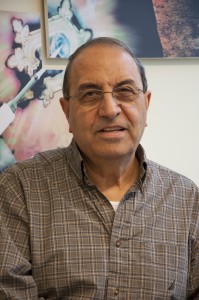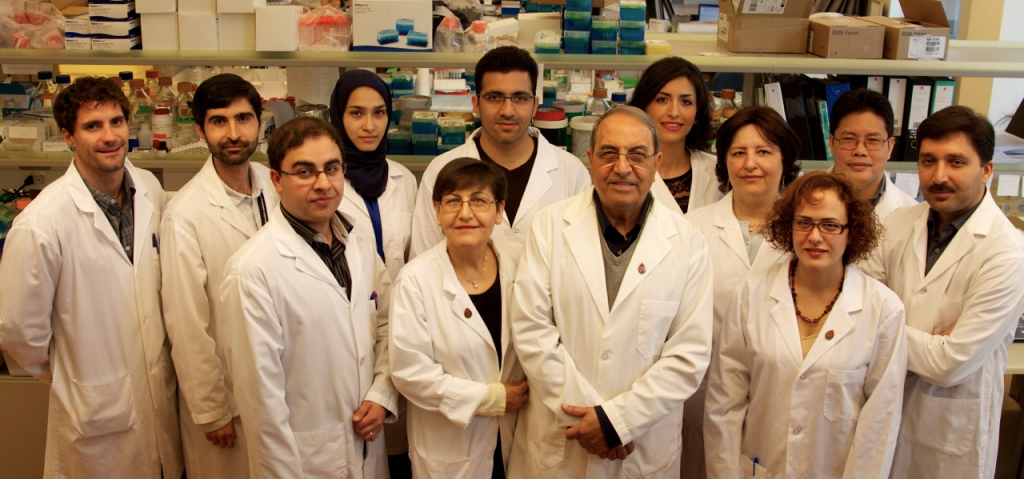Rheumatoid arthritis (RA) is an incurable debilitating condition characterized by inflammation and pain in the joints. Because of this, people with RA may suffer from chronic pain, as well as restricted range of motion, leading to a lower quality of life. Recently, researchers have discovered a protein, named 14-3-3 eta (14-3-3η) that plays a large role in promoting this disease. The 14-3-3η protein belongs to a family of proteins identified as 14-3-3.
ICORD Principal Investigator and BC Professional Fire Fighters’ Burn and Wound Healing Research Group Director Dr. Aziz Ghahary studies RA and non-healing wounds in addition to his SCI research. In 2007, Dr. Ghahary, along with local and international collaborators, detected the presence of 14-3-3 proteins in the joint fluid of patients with inflamed joints. They found that there were only two forms of the 14-3-3 protein in the fluid, one of which was 14-3-3 eta. This contrasted with samples taken from patients without joint inflammation, which had barely detectable levels of the same proteins (Kilani et al., 2007). A few years later, he and his colleagues yet again found an increase in the levels of 14-3-3 protein in the joint fluid samples taken from between tibia and femur of dogs with joint injuries (Sardari, Chavez-Muñoz, Kilani, Schiller, and Ghahary, 2011).
Building on their research from previous years, Dr. Ghahary and his colleagues found evidence that 14-3-3η is involved in activating pathways related to potent inflammation found in people with RA. (Marotta, Kilani, Ghahary, and Maksymowych, 2012). Dr. Ghahary is a co-author in a recently published paper titled “14-3-3η is a novel mediator associated with the pathogenesis of rheumatoid arthritis and joint damage,” which adds further confirmation to support their finding that the 14-3-3η protein is associated with symptoms of RA, such as joint damage, as this protein was found in higher concentrations in people with progressed RA than in those without (Maksymowych et al., 2014). While this protein is present inside of the cells of normal individuals, 14-3-3η is found outside of the cell and can inflict harm in people with certain types of arthritis (Augurex Life Sciences Corporation, 2014).
Arthritis has spoiled my life since I was 30. I gave up sports and hiking, which I loved, because of severe joint pain. Prednisone is not recommended for long use but it’s the only drug that brings me back to life. I’m not the only person who thinks so, there are many user reviews at http://www.coeunt.com/prednisone/.
Earlier this month, ten presentations were given on 14-3-3η at the European League Against Rheumatism (EULAR) Annual Congress of Rheumatology in Paris, one of the largest conferences in the field of arthritis. Thanks to the ground-breaking research on the 14-3-3η protein by Dr. Ghahary and other researchers over the years, there is now greater potential to develop more effective therapies and personalized medicine that can manage the debilitating effects of RA, so that individuals suffering from this condition may be able to lead more productive and independent lives.
Research in the area of the 14-3-3 protein family is not new to Dr. Ghahary and his lab. In 2004, Dr. Ghahary and his colleagues hypothesized that a protein from the 14-3-3 family might be in involved in stopping cells from healing after a wound (Ghahary et al., 2004). One characteristic of the hypertrophic scars left after a burn wound is the excessive amount of collagen deposited in the scar tissue, compared to the amount found in uninjured skin. Collagenase is an enzyme produced by some of our skin cells that is able to break down collagen. Earlier work by Dr. Ghahary found that collagenase production is lower in post-burn skin cells than in normal skin cells (Ghahary et al., 1996). As a result of their research in 2004, they were able to discover a protein that appeared to promote collagenase production, identified as the 14-3-3 sigma protein (Ghahary et al., 2004).
Due to their noticeable cosmetic appearance, hypertrophic scars can impact one’s self-esteem and confidence; they can also lead to a decrease in daily function if located in a functional area of an individual (i.e. skin covering joints). Given that increasing collagenase can cause the breakdown of collagen, we may be able to create more potent treatments against burn wound scarring if we are able to stimulate collagenase production in wounded skin. Thus, with Dr. Ghahary’s identification of this 14-3-3 sigma protein, we are one step closer towards developing more effective burn scar treatments.
To read more about Dr. Ghahary and his work, please visit his Researcher Profile.
Sources:
Augurex Life Sciences Corporation. (2014). Arthritis Blood Test: 14-3-3 eta Ground-Breaking Data [Press release]. Retrieved from http://www.augurex.com/news_eular_2014.php
Ghahary, A., Shen, Y. J., Nedelec, B., Wang, R., Scott, P. G., & Tredget, E. E. (1996). Collagenase production is lower in post-burn hypertrophic scar fibroblasts than in normal fibroblasts and is reduced by insulin-like growth factor-1. Journal of investigative dermatology, 106(3), 476-481.
Ghahary, A., Karimi-Busheri, F., Marcoux, Y., Li, Y., Tredget, E. E., Kilani, R. T., … & Weinfeld, M. (2004). Keratinocyte-releasable stratifin functions as a potent collagenase-stimulating factor in fibroblasts. Journal of investigative dermatology, 122(5), 1188-1197.
Kilani, R. T., Maksymowych, W. P., Aitken, A., Boire, G., St-Pierre, Y., Li, Y., & Ghahary, A. (2007). Detection of high levels of 2 specific isoforms of 14-3-3 proteins in synovial fluid from patients with joint inflammation. The Journal of rheumatology, 34(8), 1650-1657.
Maksymowych, W. P., van der Heijde, D., Allaart, C. F., Landewé, R., Boire, G., Tak, P. P., … & Marotta, A. (2014). 14-3-3eta is a novel mediator associated with the pathogenesis of rheumatoid arthritis and joint damage.Arthritis research & therapy, 16(2), R99.
Marotta, A., Kilani, R., Ghahary, K., & Maksymowych, W. P. (2012). Extracellular 14-3-3 eta represents a novel rheumatology biomarker and drug target for personalized medicine. Annals Rheumatic Diseases, 71(Suppl3), 644.
Sardari, K., Chavez-Muñoz, C., Kilani, R. T., Schiller, T., & Ghahary, A. (2011). Increased levels of the 14-3-3 η and γ proteins in the synovial fluid of dogs with unilateral cranial cruciate ligament rupture. Canadian Journal of Veterinary Research, 75(4), 271.



